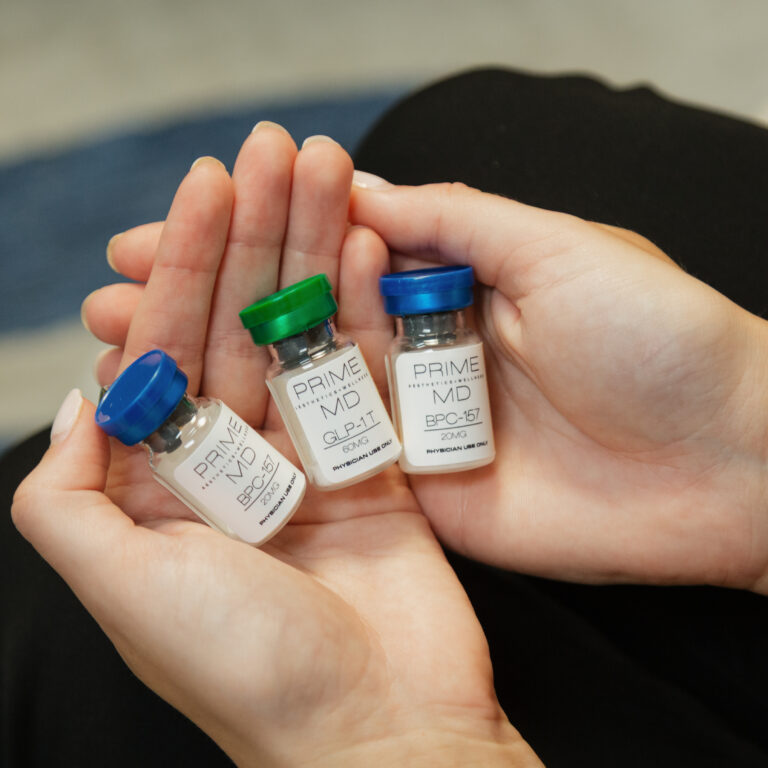


Restore Balance. Embrace Radiance.
Personalized Women’s Hormone Therapy to Support Every Stage of a Woman’s Life
Locations Offering Women's Hormone Therapy
Prime MD Raleigh, North Carolina
Prime MD Rolesville, North Carolina
Prime MD Johnson City, Tennessee
Experiencing Fatigue, Mood Swings, or Hormonal Shifts?
Women’s hormone therapy is designed to gently rebalance your body’s natural rhythms—alleviating symptoms of perimenopause, menopause, and hormonal imbalance so you can feel like yourself again: energized, centered, and vibrant.
Hormone Treatment Process
Dr. Hummel will order a customized panel of your hormones and metabolism markers and will review your result. At your consultation, after obtaining your medical history and symptom log, Dr Hummel can make treatment recommendations to help alleviate your symptoms, improve your metabolism, and optimize your hormones safely.
Pre-Menopause | Menopause
Women in their mid-thirties and forties can suffer from Pre-Menopause and in their fifties and beyond can suffer from Menopause. This causes certain hormones like estrogen, progesterone, thyroid hormones and even testosterone decline. Many physicians misdiagnose hormone deficiency related symptoms or lack sufficient experience with hormone replacement treatment programs to find appropriate solutions tailored to each patient.
As women age, hormone levels naturally decrease, causing the symptoms associated with menopause and affecting many other areas of the body and mind. Many women also experience an increase in abdominal fat due to a loss of estrogen. Experiencing loss of mental sharpness, endurance, libido, emotional well-being, physical health, or defenses against illness is normal, there are treatment programs that can prevent or reduce these symptoms.
OUR REJUVENATION TREATMENTS:
estrogen
Estrogen is a hormone made primarily in the ovaries. The three major estrogens are estradiol, estriol and estrone. Of the three, estradiol is the most physiologically and biologically active. Estrogen is not simply a sex hormone, but a total body hormone. Estrogen receptor sites are found in the bladder, bones, arteries, vagina, heart, liver and the brain. Without adequate levels of estrogen, these organs cannot function properly.
When dealing with female sex hormones, the balance amongst them often is more important than the actual levels. This is true of the ratio of estrogen to progesterone, as well as estrogen to testosterone. In females, as the progesterone to estrogen ratio decreases, it creates estrogen dominance and subsequently an increased risk of breast cancer. Estrogen and progesterone act in tandem to control cell growth for normal function.
Estrogens do many things, including increasing cell proliferation, improving neural connections in the brain, and controlling insulin levels. As total estrogen levels decrease, insulin resistance and insulin levels begin to rise. Progesterone decreases the number of receptor sites for both hormones, decreases insulin resistance and promotes new bone growth (estrogen only slows bone loss). Studies show that estrogen alone causes tissue growth in the uterus that can lead to cancer; however, when replaced in conjunction with natural progesterone, the risk is reduced or eliminated.
Bio-identical estrogens have the same molecular structure as the estrogens found in the human female. These natural plant estrogens are altered so that they have the same bioidentical structure as the estrogens found naturally in the female body.
Combining the benefits of bio-identical estrogen and progesterone replacement provide many of the benefits without the risks.
Together they can improve or prevent osteoporosis, improve mood and mental status, and improve sexual function and libido.
progesterone
Progesterone, primarily a female hormone but also found in males in small amounts, is made in the ovaries, the adrenal glands, and in the placenta during pregnancy. It is one of the major regulatory hormones. Like estrogen, progesterone levels decline with age. Female progesterone levels drop drastically at menopause. Progesterone helps estrogen levels remain within a therapeutic range and therefore, can protect against endometrial cancer of the uterus.
When dealing with female sex hormones, the balance amongst them often is more important than the actual levels. This is true of the ratio of estrogen to progesterone, as well as estrogen to testosterone. In females, a higher ratio of testosterone to estrogen is indicative of an increased risk of heart disease (the opposite is true in males). In females, as the progesterone to estrogen ratio decreases, it creates estrogen dominance and subsequently an increased risk of breast cancer. Estrogen and progesterone act in tandem to control cell growth for normal function.
Bio-identical estrogens have the same molecular structure as the estrogens found in the human female. These natural plant estrogens are altered so that they have the same bio-identical structure as the estrogens found in human females. Unlike many FDA- approved estrogen medications, natural bio identical soy-derived estrogens are safe, effective.
Combining the benefits of bio-identical estrogen and progesterone replacement provide many of the benefits without the risks. Together they can improve or prevent osteoporosis, improve mood and mental status, improve sexual function or libido.
bioidentical hormone therapy
Bio-Identical Hormone Replacement (BHRT) is the use of supplemental doses of hormones that have a chemical structure identical to the hormones that the human body naturally produces. The goal is to balance the hormones to an optimal and safe level to improve metabolic function and promote healthy aging. They are used for their cost-effectiveness and efficacy. Dr Hummel will evaluate and monitor your laboratories routinely to achieve and maintain the best levels for your body.
Bio-identical hormones are available as creams, suppositories, pills, injections, or infusions and include testosterone, estrogen, progesterone, hCG, hGH boosters, thyroid, lipotropics, NAD+.
testosterone therapy for women
Most of the research on testosterone replacement has focused on men. Nevertheless, healthy women naturally have small amounts of testosterone. Testosterone levels tend to peak when a woman is ovulating, increasing libido for reproduction. It also appears to enhance the function of estrogen and progesterone. Women who replace progesterone without testosterone often require slightly greater doses of progesterone. Testosterone may also improve various symptoms of menopause including ‘hot flashes,” weight gain, Fatigue, lethargy and may decrease the risk of breast cancer.
Researchers report that women who receive testosterone replacement therapy after menopause experience an increase in sexual drive and response, frequency of sexual intercourse, number of sexual fantasies, and level of sexual arousal. Testosterone contributes to overall muscle tone. Prior to menopause, many women experience the embarrassment of a leaky bladder. This problem may be related to diminishing testosterone levels, because the pelvic muscles are particularly dependent ontestosterone. Many women find that testosterone replacement, combined with Kegel exercises, strengthens and tones those muscles. Recent research suggests that testosterone may increase the bone’s ability to retain calcium. Women who experience very rapid bone loss are typically deficient in both estrogen and testosterone. It appears that both testosterone and estrogen independently improve bone density.
Your doctor will help you determine the best form of administering testosterone replacement. Your physician will monitor blood levels every few months until dosages are adjusted to achieve optimal levels and outcomes.
genital atrophy (shrinkage & Wasting)
Vaginal atrophy (atrophic vaginitis) is thinning, drying and inflammation of the vaginal walls due to your body having less estrogen. Simple, effective treatments for vaginal atrophy and its urinary symptoms are available.
For many women, vaginal atrophy not only makes intercourse painful, but also leads to distressing urinary symptoms. Simple, effective treatments for vaginal atrophy and its urinary symptoms are available. Reduced estrogen levels result in changes to your body, but it doesn’t mean you have to live with the discomfort.
With moderate to severe genitourinary syndrome, you may experience the following vaginal and urinary signs and symptoms:
- Vaginal dryness
- Vaginal burning
- Vaginal discharge
- Genital itching
- Burning with urination
- Urgency with urination
- More urinary tract infections
- Urinary incontinence
- Light bleeding after intercourse
- Discomfort with intercourse
- Decreased vaginal lubrication during sexual activity
- Shortening and tightening of the vaginal canal
See what Others Are Saying
Prime MD Raleigh, North Carolina
Prime MD Johnson City, Tennessee
Prime MD Rolesville, North Carolina
Follow us on Instagram
What`s worse - an empty stocking or one filled with stuff you`ll never use?
Send him this! Or better yet, swing by 12/22 or 12/23 to snag some of our favorite stocking stuffers before the holiday. 🎅
All you`ll have to do on Christmas morning is act surprised. ✨️
What`s worse - an empty stocking or one filled with stuff you`ll never use?
Send him this! Or better yet, swing by 12/22 or 12/23 to snag some of our favorite stocking stuffers before the holiday. 🎅
All you`ll have to do on Christmas morning is act surprised. ✨️
...
✨ THE WINTER SOIRÉE ✨
Our biggest beauty event of the year drops MONDAY! Here’s your sneak peek:
✨ 20% OFF Gift Cards
Pay 80% → Get 100% (Valid 12 months)
✨ Buy the Bottle of Tox
100 units for $1,200
Max 2 per client • Bank for 1 year
🎁 Early Bird Luxe Swag
First 10 clients to spend $1,500 get a $250+ curated gift
(Lulu Belt Bag, Voluspa Candle, Starbucks, skincare + more)
🎟️ Winter Soirée Raffle
Every purchase = entry
Prizes: Alastin basket, Hydrinity basket, Lip Filler, Dysport, Sculptra, ZO favorites,
$2,000 Prime MD Gift Card (Grand Prize)
🧴 Skincare Specials
20% off all skincare
Spend $500+ → BONUS gift
❗️All specials go LIVE Monday
✨ THE WINTER SOIRÉE ✨
Our biggest beauty event of the year drops MONDAY! Here’s your sneak peek:
✨ 20% OFF Gift Cards
Pay 80% → Get 100% (Valid 12 months)
✨ Buy the Bottle of Tox
100 units for $1,200
Max 2 per client • Bank for 1 year
🎁 Early Bird Luxe Swag
First 10 clients to spend $1,500 get a $250+ curated gift
(Lulu Belt Bag, Voluspa Candle, Starbucks, skincare + more)
🎟️ Winter Soirée Raffle
Every purchase = entry
Prizes: Alastin basket, Hydrinity basket, Lip Filler, Dysport, Sculptra, ZO favorites,
$2,000 Prime MD Gift Card (Grand Prize)
🧴 Skincare Specials
20% off all skincare
Spend $500+ → BONUS gift
❗️All specials go LIVE Monday
...
We’re Hiring! 🧖🏻♀️
PrimeMD Rolesville is looking for an experienced Medical Aesthetician to join our team.
Think you’d be a great fit?
Check out the link in our bio for info & applying!
We can’t wait to meet you! 🤍
We’re Hiring! 🧖🏻♀️
PrimeMD Rolesville is looking for an experienced Medical Aesthetician to join our team.
Think you’d be a great fit?
Check out the link in our bio for info & applying!
We can’t wait to meet you! 🤍
...
Your words mean the world world to us. Thank you for trusting us with your skin! 💛
@juliainjects
#googlereviews #thankful #skincare #rolesvillenc #wakeforestnc #rolesvillemedspa #dermalfıllers #aestheticsandwellness #primemdaesthetics #glowingskin #trustedprovider #resultsdriven
Your words mean the world world to us. Thank you for trusting us with your skin! 💛
@juliainjects
#googlereviews #thankful #skincare #rolesvillenc #wakeforestnc #rolesvillemedspa #dermalfıllers #aestheticsandwellness #primemdaesthetics #glowingskin #trustedprovider #resultsdriven
...
We fall in love with this. every. single. day.
#fallinlovewithyourskin🧖🏼♀️ #fallinloveagainandagain #rolesvillenc #primemdaesthetics #wakeforestnc #raleighmedspa #raleighbotox #botox #dysport #hydrafacials #aesthetics #lipfiller #skinrejuvination #medspalife #selfcare #wellness
We fall in love with this. every. single. day.
#fallinlovewithyourskin🧖🏼♀️ #fallinloveagainandagain #rolesvillenc #primemdaesthetics #wakeforestnc #raleighmedspa #raleighbotox #botox #dysport #hydrafacials #aesthetics #lipfiller #skinrejuvination #medspalife #selfcare #wellness
...
✨️ INTRODUCING ✨️
Our newest medical aesthetician, Courtney Elsmore, LE!
Some of you may recognize Courtney from our Raleigh location, but the Rolesville office is thrilled that Courtney will be all ours on Thursdays and Fridays for all of your favorite self-care rituals! 💆🏼♀️
.
.
.
A little about Court:
🌟 HER FAV TREATMENT: "A Hydrafacial or Microneedling treatment!"
🌟 WHERE YOU`LL FIND HER ON THE WEEKENDS: "Spending quality time with my family and friends"
🌟 STARBUCKS DRINK: "A green tea matcha" 🍵
🌟 WHAT SHE WANTS YOU TO KNOW: "One thing I wish patients knew is that I don’t just see your skin, I see YOU. Skincare is about feeling confident and comfortable in your own skin, which takes patience, consistency, and trust!"
Courtney specializes in custom skincare regimens and problematic skin. As a long-term acne sufferer herself, she understands the emotions and devotion necessary to achieve your best skin and will help you through every step of the process! 🤍
To celebrate her arrival, Courtney is offering complimentary facials for a limited time to new clients! Call 919-948-6355 option 2 to book with her ✨️
Be sure to follow us and Courtney @courtaesthetica for future promotions and events!
✨️ INTRODUCING ✨️
Our newest medical aesthetician, Courtney Elsmore, LE!
Some of you may recognize Courtney from our Raleigh location, but the Rolesville office is thrilled that Courtney will be all ours on Thursdays and Fridays for all of your favorite self-care rituals! 💆🏼♀️
.
.
.
A little about Court:
🌟 HER FAV TREATMENT: "A Hydrafacial or Microneedling treatment!"
🌟 WHERE YOU`LL FIND HER ON THE WEEKENDS: "Spending quality time with my family and friends"
🌟 STARBUCKS DRINK: "A green tea matcha" 🍵
🌟 WHAT SHE WANTS YOU TO KNOW: "One thing I wish patients knew is that I don’t just see your skin, I see YOU. Skincare is about feeling confident and comfortable in your own skin, which takes patience, consistency, and trust!"
Courtney specializes in custom skincare regimens and problematic skin. As a long-term acne sufferer herself, she understands the emotions and devotion necessary to achieve your best skin and will help you through every step of the process! 🤍
To celebrate her arrival, Courtney is offering complimentary facials for a limited time to new clients! Call 919-948-6355 option 2 to book with her ✨️
Be sure to follow us and Courtney @courtaesthetica for future promotions and events!
...
⭐️⭐️⭐️⭐️⭐️
This is the "why" behind what we do! 🫶
.
.
.
#beYOUtiful #bestmedsparaleigh #selfcareraleigh #facialbalancingraleigh #raleighfacial #raleighhydrafacial #rolesvillenc #wakeforestnc
⭐️⭐️⭐️⭐️⭐️
This is the "why" behind what we do! 🫶
.
.
.
#beYOUtiful #bestmedsparaleigh #selfcareraleigh #facialbalancingraleigh #raleighfacial #raleighhydrafacial #rolesvillenc #wakeforestnc
...
For a limited time, we`re offering all new aesthetics clients 15% off of their first visit! 🎉
Come experience the luxury and expertise our team has to offer, and let us help you look and feel your best!
.
.
.
#inmyprime #raleighnc #bestofraleigh #rolesvillenc #selfcareraleigh #nurseinjectorraleigh #estheticianraleigh #bestfacialraleigh #facialbalancingraleigh #lipfillerraleigh
For a limited time, we`re offering all new aesthetics clients 15% off of their first visit! 🎉
Come experience the luxury and expertise our team has to offer, and let us help you look and feel your best!
.
.
.
#inmyprime #raleighnc #bestofraleigh #rolesvillenc #selfcareraleigh #nurseinjectorraleigh #estheticianraleigh #bestfacialraleigh #facialbalancingraleigh #lipfillerraleigh
...
The. Best. Feeling. 🧖🏻♀️✨
#rolesvillenc #primemdaesthetics #wakeforestnc #raleighmedspa #hormonereplacementtherapy #primemdwellness #skin #hydrafacials #rolesvillemedspa #botox #facials
The. Best. Feeling. 🧖🏻♀️✨
#rolesvillenc #primemdaesthetics #wakeforestnc #raleighmedspa #hormonereplacementtherapy #primemdwellness #skin #hydrafacials #rolesvillemedspa #botox #facials
...
Our favorite place to be! 💉🧖🏻♀️🪞 ...
Just kidding. We’re looking for YOU!
📅 Link in bio to book
🤍 We can’t wait to see you
.
.
.
#rolesvillenc #primemdaesthetics #lookingforaman #raleighbotox #raleighaesthetics #wakeforestnc #hormonereplacementtherapy #primemdwellness #youngsvillenc #newpatients #booknow #skincare #beauty
Just kidding. We’re looking for YOU!
📅 Link in bio to book
🤍 We can’t wait to see you
.
.
.
#rolesvillenc #primemdaesthetics #lookingforaman #raleighbotox #raleighaesthetics #wakeforestnc #hormonereplacementtherapy #primemdwellness #youngsvillenc #newpatients #booknow #skincare #beauty
...
Sorry I really was busy I promise 🧖🏻♀️💉
.
.
.
.
.
.
.
.
.
.
#rolesvillenc #primemdaesthetics #wakeforestnc #raleighmedspa #raleighbotox #botox #hormonereplacementtherapy #primemdwellness #dysport #hydrafaci̇al #chemicalpeels #skincare #youngsvillenc
Sorry I really was busy I promise 🧖🏻♀️💉
.
.
.
.
.
.
.
.
.
.
#rolesvillenc #primemdaesthetics #wakeforestnc #raleighmedspa #raleighbotox #botox #hormonereplacementtherapy #primemdwellness #dysport #hydrafaci̇al #chemicalpeels #skincare #youngsvillenc
...
The holiday EPICUTIS box is an extra $50 dollars off if purchased before the end of December! A total savings of $280. The boxes are originally $730, but they’re on sale for $450!🎄
The holiday EPICUTIS box is an extra $50 dollars off if purchased before the end of December! A total savings of $280. The boxes are originally $730, but they’re on sale for $450!🎄 ...
Sleigh your Christmas list with our gift card specials❤️🎅
Sleigh your Christmas list with our gift card specials❤️🎅 ...
Holiday hours for next week!🎄 ...
Book with us now!!
📞(423)-430-8323
✉️Jc@primemdcenter.com
🔗primemdcenter.com
Book with us now!!
📞(423)-430-8323
✉️Jc@primemdcenter.com
🔗primemdcenter.com
...
Stocking Stuffer Ideas✨
All of these items can be purchased at Prime!
📞(423)-430-8323
✉️Jc@primemdcenter.com
🔗primemdcenter.com
Stocking Stuffer Ideas✨
All of these items can be purchased at Prime!
📞(423)-430-8323
✉️Jc@primemdcenter.com
🔗primemdcenter.com
...
@theskintaylar is a Licensed Esthetician and Certified Clinical Medical Assistant with a deep passion for skin health and helping clients feel confident in their own skin. She has been part of the aesthetics industry since 2021 and proudly serves clients at PrimeMD Aesthetics + Wellness, where she has been perfecting her craft since January 2023.
Taylar specializes in custom facials, brow tinting, lamination, waxing, and lash lifts, and takes pride in tailoring each treatment to meet her clients’ unique goals, no matter how big or small! Her clinical background and results-driven approach are balanced with the perfect amount of correction and relaxation. Providing a genuine care for each person she works with, creating a welcoming and transformative experience.
Outside of the treatment room, Taylar finds joy in her cozy, love-filled home with her three dogs and four cats, and is newly engaged to her fiancé of six years. Whether she’s perfecting a client’s glow or spending time with her furry family, Taylar brings the same warmth, dedication, and attention to detail to everything she does. ✨🧖♀️
@theskintaylar is a Licensed Esthetician and Certified Clinical Medical Assistant with a deep passion for skin health and helping clients feel confident in their own skin. She has been part of the aesthetics industry since 2021 and proudly serves clients at PrimeMD Aesthetics + Wellness, where she has been perfecting her craft since January 2023.
Taylar specializes in custom facials, brow tinting, lamination, waxing, and lash lifts, and takes pride in tailoring each treatment to meet her clients’ unique goals, no matter how big or small! Her clinical background and results-driven approach are balanced with the perfect amount of correction and relaxation. Providing a genuine care for each person she works with, creating a welcoming and transformative experience.
Outside of the treatment room, Taylar finds joy in her cozy, love-filled home with her three dogs and four cats, and is newly engaged to her fiancé of six years. Whether she’s perfecting a client’s glow or spending time with her furry family, Taylar brings the same warmth, dedication, and attention to detail to everything she does. ✨🧖♀️
...
Start buying your gift cards for this holiday season! 🎄
📞(423)-430-8323
✉️Jc@primemdcenter.com
🔗primemdcenter.com
Start buying your gift cards for this holiday season! 🎄
📞(423)-430-8323
✉️Jc@primemdcenter.com
🔗primemdcenter.com
...
Winter season is here! Book your facials with @theskintaylar and @kln.aesthetics ! 🧖♀️
📞(423)-430-8323
✉️Jc@primemdcenter.com
🔗primemdcenter.com
Winter season is here! Book your facials with @theskintaylar and @kln.aesthetics ! 🧖♀️
📞(423)-430-8323
✉️Jc@primemdcenter.com
🔗primemdcenter.com
...
We love hearing your questions!
Drop more questions in the comment section and we will message you individually!💋
📞(423)-430-8323
✉️Jc@primemdcenter.com
🔗primemdcenter.com
We love hearing your questions!
Drop more questions in the comment section and we will message you individually!💋
📞(423)-430-8323
✉️Jc@primemdcenter.com
🔗primemdcenter.com
...
Winter Soirée Specials✨
December 1st-5th‼️
📞(423)-430-8323
✉️Jc@primemdcenter.com
🔗primemdcenter.com
Winter Soirée Specials✨
December 1st-5th‼️
📞(423)-430-8323
✉️Jc@primemdcenter.com
🔗primemdcenter.com
...
Book with us now!! 📞(423)430-8323
https://primemdcenter.com/contact-us/contact-prime-md-johnson-city/
Book with us now!! 📞(423)430-8323
https://primemdcenter.com/contact-us/contact-prime-md-johnson-city/
...
Our beautiful @injector.linds in action! 💉🤍 ...


